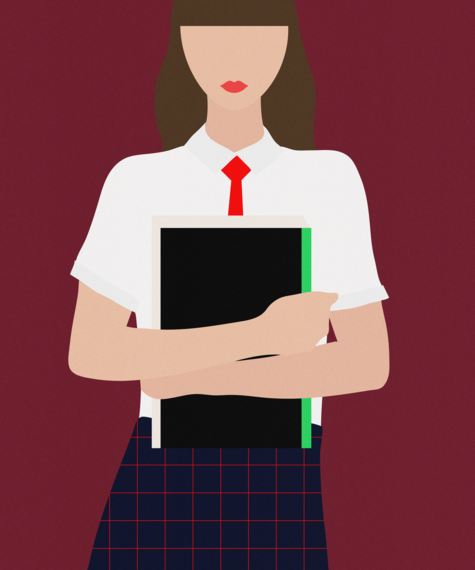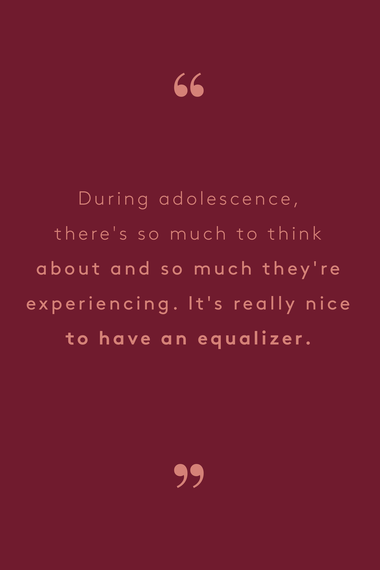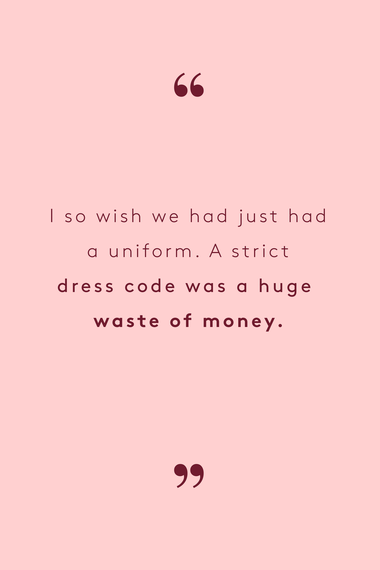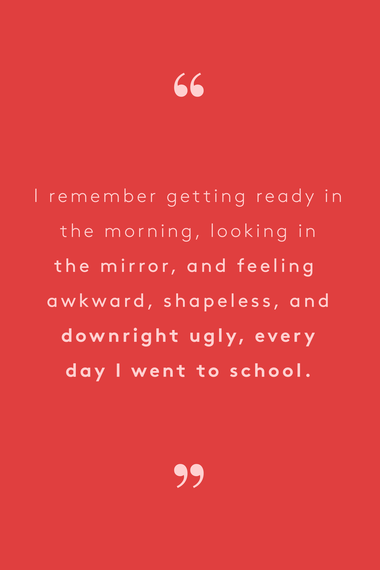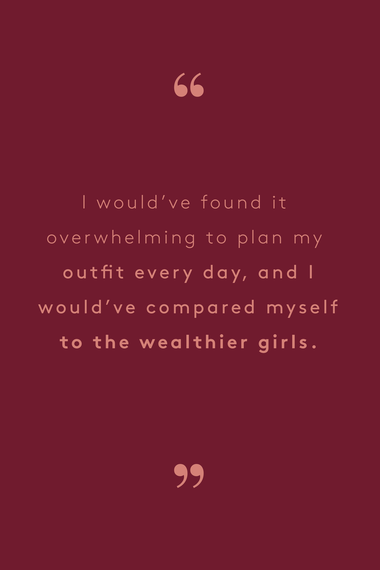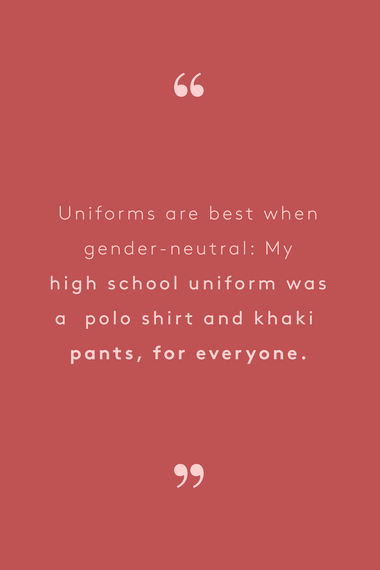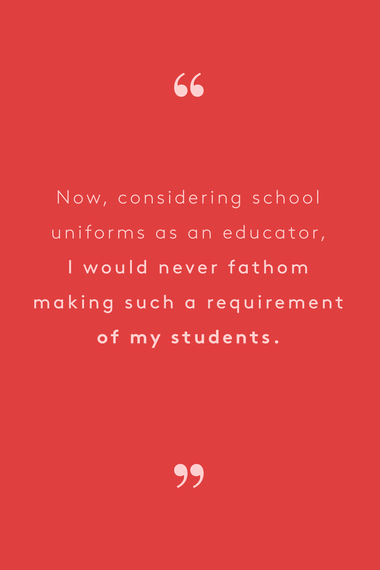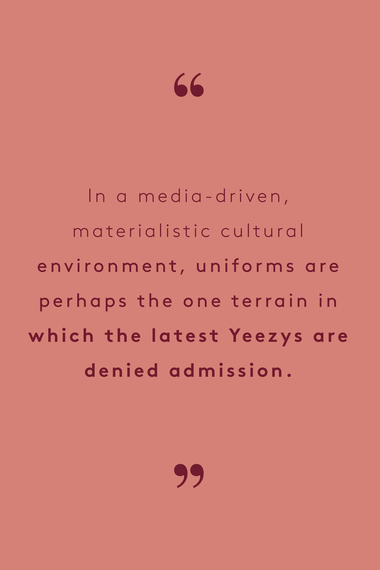![2016-09-09-1473421996-2415682-image.png]()
School uniforms are a daily reality for many students at countless institutions around the world. So are dutifully enforced dress codes, which dictate what is and isn't kosher to wear to class without prescribing specific items. Uniforms and dress codes certainly aren't new aspects of the scholarly experience, but the value of policing kids' and teens' wardrobe choices has come under fire a lot in the past year. Considering all this controversy over "appropriate" attire in academia, is it really necessary or worthwhile for schools to continue calling the shots fashion-wise in 2016?
Some schools have
mandated longer skirts for female students, while others have
even sent students home for having supposedly too-short skirts and overly snug pants. Then, there are students who've fought back against uniform mandates, whether by
bending gender norms and creating petitions to affect change or wearing
scarlet letters in protest.
Not all news about fashion's role in academia is bad news, though. Some institutions have progressively adopted
gender-neutral uniform rules. Schools in traditionally conservative cultures are even are moving away from policies that rigidly adhere to the gender binary to ensure LGBT students are
more comfortable in the classroom.
It's a really polarizing topic, to put it lightly. We scoured around for a range of perspectives about the joys and frustrations that result from having a uniform or dress code. Ahead, 15 people sound off on being told what you can and can't wear to class, whether they spent their formative years attired according to a uniform, grappled with adhering to a nebulous dress code -- or, in some cases, actually wish they'd had guidelines for getting dressed each morning.
![2016-09-09-1473422137-6862067-image1.png]()
"I wore a uniform starting in kindergarten through when I went to college -- and I absolutely loved it. I definitely see both sides of the argument. During adolescence, there's so much for teenagers to think about and so much that they're experiencing. It's really nice to have an equalizer.
"I don't think I always had this opinion, but looking back, I think having a uniform was actually the impetus for why I love getting dressed now...when I got to college, I started experimenting with my own style and understanding the value of dressing for my body, rather than dressing for other people." -- Athena Chen
![2016-09-09-1473422180-3028948-image2.png]()
"A school uniform can be very different things to different people, ergo the endless controversy. For me, it was a blessing for three reasons: as a socioeconomic equalizer, a reprieve from all of the effort and judgment and menial mental exhaustion usually spent on clothing, and a way to, at least superficially, fit in when it was painfully clear to me that I did not.
"I spent 12 years at a private, all-girls school where the tuition costs as much as most universities, and as far as I can tell, only a third of my classmates' mothers were employed. It was rarely spoken of directly, but money (and more importantly to girls too young to have real direct experience with it, its trappings) was paramount to the culture of the place. There are many ways to communicate wealth: the cars your parents drive, the gifts you show off the day after your birthday, the destinations of your summer vacations -- but the easiest and most omnipresent is your clothing.
"To give you a taste of it, there was a notorious Lilly Pulitzer sale each year on the Main Line in which a whole store-load of discounted crocodile-print sundresses would be made available for 40% of original price, which never failed to generate astonishing stories of block-long lines, stampeding moms, and dressing-room thievery. Money played an oversized role in the culture of the school; I can only imagine the arms race had we been allowed to dress as we (or our parents) saw fit.
"Middle and high school is emotionally difficult, full stop. For me, with about five of those years spent plunging publicly into, and then slogging out, of life-threatening clinical depression, it was also agonizing and exhausting and nearly impossible. Being able to wake up every day and allow muscle memory to handle the donning of an ugly, starched kilt allowed me reprieve from yet another source of decision fatigue.
"It was also a chance to blend in with the normal kids. To a young teenager with the unfortunate combination of rampant insecurity and debilitating depressive fatigue, having a mandatory way to fake normal and direct attention away from me was a beautiful thing. I felt like human skin stretched too tight over a supermassive black hole, but when I walked the halls of the Agnes Irwin school, superficially at least, I was just another blue-and-white-garbed girl, blissfully indistinguishable from all the others." -- Anonymous
![2016-09-09-1473422212-2737774-image3.png]()
"I went to Noble and Greenough School, which is a small, private co-ed high school school outside of Boston. We didn't have uniforms, but we had a strict dress code. Essentially, it was no jeans, no leggings, all skirts and shorts down to the top of the kneecap, no sweatshirts, no writing on any clothing, no open-toed shoes or flip-flops, guys couldn't have anything pullover, and certain colors weren't permitted.
"Over the years, I found that the items we could wear to school were so much more expensive than the items that were forbidden. Finding corduroys or nice khaki pants is more expensive than getting a pair of jeans from T.J. Maxx! Sweaters are more expensive than sweatshirts; leather shoes more expensive than other materials.
"When a friend would found a basic pair of corduroys for the fall, we'd all ask where she got them. Then, we'd all go and get the same pairs, anyways. So essentially, my close girlfriends and I ended up in our own expensive uniform looks of our own. When I went to college, I didn't want to wear those clothes anymore. I only had one pair of jeans, since I could never wear them to school, so I had to go out and basically buy a new wardrobe.
"I so wish we had just had a uniform. A strict dress code was a huge waste of money." -- Mariah Pongor
![2016-09-09-1473422287-2591932-image4.png]()
"I grew up going to one of many all-girls Catholic schools in the Philippines, a country that is over 85% Catholic. Some of the rules on our uniforms didn't ever make sense to me -- our plain, white socks, for example, had to fully cover our ankle bones at all times. For P.E., we were required to wear knee-length grey skorts -- not shorts! -- through the seventh grade, when we could finally don black sweatpants, instead.
"I remember sitting and squirming in my scratchy plaid skirt, which had to fall to my shins, despite Manila's 90° weather. I remember getting ready in the morning, looking in the mirror, and feeling awkward, shapeless, and downright ugly every day I went to school. I thought I'd grow up, look back, and think, that wasn't so bad...still not the case." -- Isabel Francisco
![2016-09-09-1473422326-893892-image5.png]()
"I wore uniforms from preschool through high school and I LOVED it. Granted, I went to an all-girls Catholic high school, so I didn't experience any of the sexism associated with co-ed clothing standards. But I still believe uniforms are the best way to keep the focus on learning, as opposed to status.
"I would've found it overwhelming to plan my outfit every day and I would've compared myself to the wealthier girl. I would've felt inferior if I didn't have the cool new Frankie B. jeans, Tory Burch flats, or Juicy bags. That shit matters to 15-year-old girls, unfortunately.
"Being able to wake up at the last minute, throw on the same thing as the day before, and skip hair and makeup was the best. Granted, when it came time to go out on the weekends or pack my suitcases for college, I had about 10 non-uniform clothing items to choose from.
"To this day, I would love to have a uniform -- I'd wear jeans, a T-shirt, and Converses every single day if it was acceptable." -- Alix Tunell
![2016-09-09-1473422365-8031609-image6.png]()
"I always had a uniform. My uniforms varied from complex (tights, pleated skirt, button-down, tie, sweater, blazer, specified shoes, and even a hat) to very simple (polo shirt, khaki pants, and my choice of any closed-toe shoes). However, regardless of how complex or lax my uniform regulations were, I always loved having a uniform; they just simplified my life. To note, I'm cis-gender woman, which made it far easier for me in terms of certain regulations, like wearing skirts.
"Uniforms granted me the ability to not care at all about my presentation at school; I never had to think about what to wear in the morning. I could just wake up, roll out of bed, and throw on a pre-designated outfit. I adored the simplicity and I wish I still had a uniform. When I was younger, I was more self-conscious; I never had to be concerned with whether I was as stylish as my fellow classmates.
"While I had a great experience, I do feel that many of the motivations behind uniforms are insanely problematic. Oftentimes, schools over-penalize young women and girls for dress-code violations, or implement uniforms due to outdated sexist notions that female students are a distraction to their male counterparts. It's disgusting and it sends a message that females are sexual objects and males are idiots who are incapable of controlling their sexual desires. It's offensive to everyone.
"Uniforms are best when gender-neutral. My high school uniform was a polo shirt and khaki pants for everyone. It was simple, comfortable, and gender-neutral, while also allowing for individual expression. The school allowed you to wear any closed-toe shoes you felt comfortable in, allowed for jewelry, and dyed hair. It was a great intersection of uniformity and individual expression." -- Lidiana Economou
![2016-09-09-1473422420-3188828-image.png]()
"Growing up in NYC, I attended public school and never had the opportunity to wear a school uniform. My cousins went to Catholic school and I was always present when their new school uniforms arrived towards the end of the summer. The collared shirts, pleated skirts, knee-socks intrigued me. My public-school friends and I sometimes entertained the idea of uniforms; discussing the ease and femininity of the preplanned outfits.
"Now, considering school uniforms as an educator, I would never fathom making such a requirement of my students. I teach preschool and I realize, even at such a young and tender age, how important it is for children to be able to express themselves. Building autonomy is so imperative in children's lives; allowing them to outwardly self express through fashion is one way for children to build a sense of self, as well as their own sense of style. "-- Alexandra Mikhailoff
![2016-09-09-1473422456-3353367-image.png]()
"Critics of uniforms today have myriad reasons to dislike them. It's argued that uniforms are passé -- relics of a more conservative past that we can't seem to do away with. Or that uniforms are direct examples of church and/or state policing young bodies or sartorial sins that continue to stymie creativity and self-expression. These observations are not far from the truth.
"Yet after spending literally half of my life wearing a uniform to attend school every day, I can think of at least two powerful reasons to keep them around for the time being.
"First, practicality. You wake up in the morning and you know exactly what you'll wear that day. (And the next one. And the next...) Yes, the monotony can be devastating. But think about the time and the mental energy that you saved by not stressing out over what to wear today. You'll automatically focus on more important matters, such as school.
"Second, egalitarianism -- or the illusion of it. More and more, our consumerist culture intrudes upon the classroom, filling young children's heads with status symbols that they absolutely must own and display for all their peers to admire. In a media-driven, materialistic environment, uniforms are perhaps the one terrain in which the latest Yeezys are denied admission.
"Uniforms ensure that, regardless of family income or class, students are met on an equal playing field. In a world in which the gap between the have and the have-nots is alarmingly widening, it might be necessary to have one space, however superficial, where students are encouraged to zoom in on what really matters: their own academic promise." -- L. Seda
For more uniform stories, visit
Refinery29.
By: Alexandra Ilyashov
-- This feed and its contents are the property of The Huffington Post, and use is subject to our terms. It may be used for personal consumption, but may not be distributed on a website.
